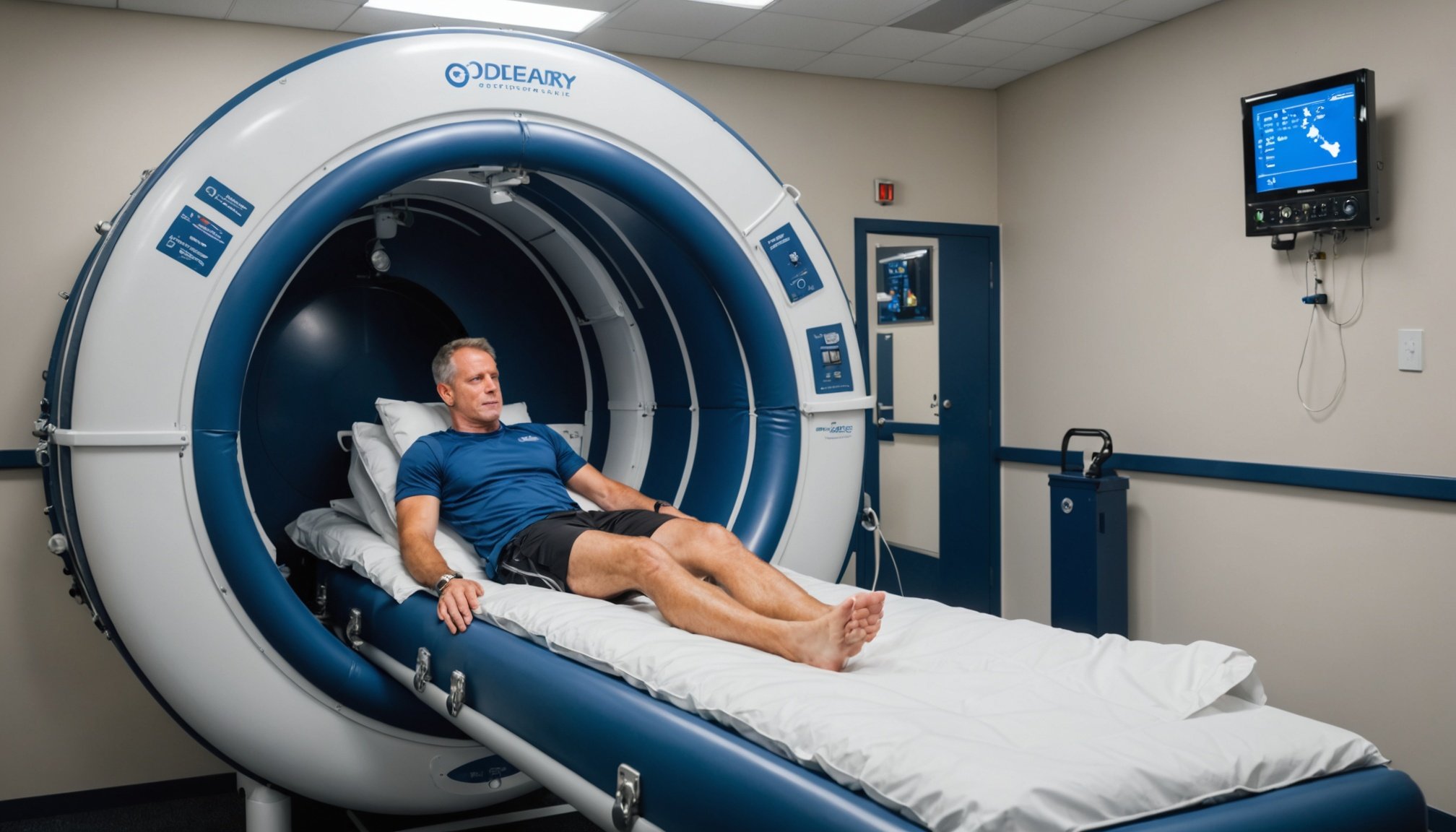Understanding Hyperbaric Oxygen Therapy
Hyperbaric Oxygen Therapy (HBOT) is a medical treatment where patients breathe pure oxygen in a pressurised environment. This process enhances oxygen diffusion into the bloodstream, aiding in the repair and regeneration of tissues. Originally used for decompression sickness, HBOT has expanded its applications to include various health benefits, most notably in athletic recovery.
The physics behind HBOT involves increasing atmospheric pressure, which allows a greater amount of oxygen to dissolve in the blood. Under normal conditions, oxygen is transported mainly by haemoglobin in red blood cells. However, with HBOT, oxygen dissolves more readily in all body fluids, delivering more oxygen to injured tissues and promoting faster healing.
Also to discover : Unlocking Mental Resilience: The Ultimate Guide to Training Young Athletes in Sports Academies
Athletes often use hyperbaric chambers for recovery, seeking to exploit HBOT’s ability to reduce inflammation and enhance tissue regeneration. These chambers come in various forms, from soft-sided models easily accessible for personal use to rigid, hospital-grade versions providing higher pressures. In athletic recovery, their appeal lies in the potential to accelerate recovery times and improve overall performance, allowing athletes to return to training and competition more quickly. This burgeoning interest in HBOT highlights its role in modern sports science as a vital tool for achieving optimal athletic recovery.
Benefits of Hyperbaric Oxygen Therapy for Athletes
Athletes constantly seek ways to enhance recovery and improve athletic performance. One promising method is Hyperbaric Oxygen Therapy (HBOT). It offers multiple benefits, making it an attractive option for those in the athletic community.
Have you seen this : Unlocking Youth Sprinting Potential: Proven Strategies to Boost Speed in Young Athletes
Firstly, HBOT accelerates the healing of injuries by improving circulation. When athletes sustain injuries, adequate blood flow to the affected area is crucial for tissue repair. Increased levels of oxygen delivered by HBOT promote efficient recovery.
Furthermore, the therapy significantly reduces inflammation and swelling in soft tissue injuries. Inflammation is a common response to injury, often hindering performance or prolonging downtime. By minimising this response, HBOT facilitates a quicker return to activity.
Additionally, HBOT enhances oxygen delivery to muscles, enabling faster recovery. Oxygen is vital for muscle repair, allowing athletes to recover more swiftly between training sessions or competitive events.
Overall, the benefits of HBOT, such as accelerated healing, reduced inflammation, and enhanced oxygen delivery, contribute to improved recovery and athletic performance. Such significant advantages make it a valuable tool for athletes eager to maintain peak condition.
Scientific Research and Evidence
Hyperbaric Oxygen Therapy (HBOT) has attracted considerable attention in sports medicine research. Key studies have illustrated its potential efficacy among athletes, enhancing recovery and performance metrics. Evidence from clinical trials frequently points to improvements in muscle regeneration and reduced fatigue. A notable study demonstrated that athletes experienced accelerated healing of muscle injuries compared to traditional recovery methods.
Several HBOT studies focus specifically on case studies, revealing personal anecdotes and athlete testimonies. A famous track athlete, for instance, reported significantly decreased recovery times after incorporating HBOT into their regimen. Such firsthand accounts bolster the confidence of trainers and sports physicians considering HBOT.
Despite these promising results, research conflicts persist within the scientific community. Some scholars highlight inconsistencies across studies, particularly concerning long-term effects and standardized protocols. This divergence in findings necessitates a cautious approach for practitioners and underscores the need for further exploration into HBOT’s nuances.
However, a burgeoning consensus among experts suggests that with controlled application, HBOT can be a viable tool in sports medicine. Thus, emerging studies and larger clinical trials are instrumental in solidifying its role in athletic recovery and performance enhancement.
Potential Side Effects and Considerations
When considering hyperbaric oxygen therapy (HBOT), it’s essential to be aware of potential side effects and athlete precautions. Common side effects associated with HBOT include ear pressure discomfort, sinus pain, and temporary vision changes. These effects are typically mild and resolve after treatment.
The safety of hyperbaric therapy is generally well-documented, but certain safety precautions should be taken, especially for athletes. Athletes may face additional risks such as exacerbation of existing conditions or issues related to changing pressure levels. It’s crucial for athletes to understand these precautions and discuss any concerns they might have with a healthcare provider.
Consulting healthcare professionals before undergoing HBOT is essential. A thorough medical evaluation can identify contraindications such as untreated asthma, chronic obstructive pulmonary disease, or recent ear surgery. This consultation ensures that the therapy is safe and tailored to individual health needs.
In summary, while HBOT can be beneficial, understanding potential side effects and precautions is necessary to safeguard one’s health, particularly for those actively involved in sports or other high-performance activities.
Practical Applications of HBOT in Sports
Hyperbaric oxygen therapy (HBOT) is gaining attention as an effective tool in sports recovery methods. Athletes are integrating HBOT into their training routines, thanks to its unique ability to expedite the healing process. The practical applications of HBOT in sports include enhanced recovery from strenuous activities, reduced inflammation, and improved endurance. Many professional sports teams now recommend specific HBOT protocols, which often involve a combination of pre- and post-workout sessions to maximise performance benefits.
When comparing HBOT with traditional recovery methods, significant differences emerge. Unlike conventional practices such as ice baths and massage therapy, HBOT delivers concentrated oxygen under pressure, promoting faster cellular recovery. These HBOT protocols are seen as innovative, with many athletes and trainers highlighting the reduced downtime and increased efficiency in sports recovery methods.
Incorporating HBOT into everyday training schedules can be seamless. Many athletes find it advantageous to schedule sessions during rest days or even immediately post-exercise to alleviate fatigue and accelerate muscle repair. To achieve optimal results, it is crucial to tailor HBOT protocols to individual needs, factoring in intensity, frequency, and the specific nature of the sport involved.
Expert Opinions on Hyperbaric Oxygen Therapy
Sports medicine professionals have increasingly acknowledged the potential benefits of Hyperbaric Oxygen Therapy (HBOT). Many experts in the field of sports medicine cite HBOT’s role in enhancing healing processes, which can significantly benefit athlete recovery strategies. The therapy is praised for its ability to increase oxygen supply to injured tissues, expediting recovery times.
Professional athletes have also been vocal proponents of HBOT. They often share personal insights into its effectiveness in accelerating recovery and improving overall performance longevity. For these athletes, the anecdotal evidence of reduced soreness and faster healing time makes HBOT a compelling addition to their recovery routines.
Future trends in athlete recovery practices are likely to increasingly incorporate advanced technologies like HBOT. Experts anticipate a continued evolution in sports rehabilitation, with an emphasis on integrating more scientific and technology-driven solutions. As awareness of HBOT’s benefits grows, it’s expected that athlete recovery strategies will adapt accordingly, further supporting both the physical and mental health of athletes. This forward-looking approach reflects the sports medicine community’s commitment to leveraging innovative recovery practices to optimize athletic performance and well-being.







